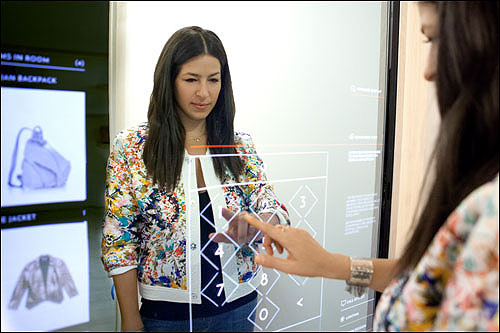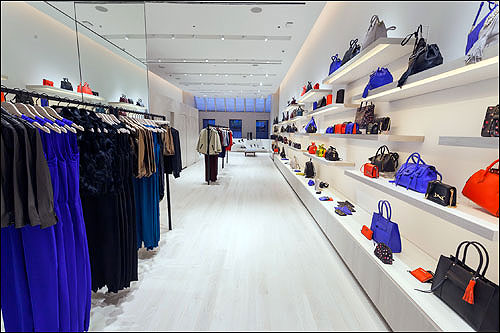Rebecca Minkoff‘s new clothing store in New York City’s SoHo neighborhood is slated to open today, featuring smart technology provided by eBay Inc.‘s Retail Innovation team and RFID tags and consultation from Avery Dennison Retail Branding and Information Solutions (RBIS). Thanks to the RFID system, the store can now identify which garments a shopper brings into a fitting room, and he or she can then request other items displayed on the room’s mirror, which also acts as a touchscreen. That, along with infrared (IR) sensors to anonymously identify where people move throughout the store, and the staff’s use of iPads to transact purchases, is intended to make shopping as effortless and seamless as it is when shopping online, the retailer reports.
The point-of-sale and inventory management software, residing on a cloud-based server, was provided by Teamwork Retail, a Florida-based mobile-software company.
Rebecca Minkoff’s company began working on this project with eBay about a year ago as it prepared to open its first brick-and-mortar store in SoHo. At that time, the firm wanted the store to be an integrated experience allowing shoppers to gain the benefits of seeing, touching and trying on garments, while also receiving suggestions related to other apparel they might like, and making payments via tablets carried by store personnel.

EBay Inc. has had a Retail Innovation team for about a year and a half, led by Healey Cypher. “My team is looking across the entire eBay portfolio,” Cypher says, “looking at online technology and figuring out ways to infuse it into the real world.” Although many consumers carry smartphones, which they use for browsing the Web, making phone calls and texting, he says the intent of stores like Rebecca Minkoff is to raise shoppers’ attention away from their phones and up to the garments and wall-mounted mirrors that feature touchscreen surfaces displaying some of those garments.
With the technology, Cypher says, the SoHo store offers “a beautiful, seamless experience” in which shoppers can spend less time in the dressing rooms, while trying on more items, and making a fast purchase via a sales rep wielding an iPad. In a fitting room, the technology can also help a shopper adjust the lighting to match the conditions in which she plans to wear the garments, identify any other items—displayed on the touchscreen—that she may wish to try on, and contact a sales rep to have them brought to the fitting room.
To make all of this possible, a single Impinj Speedway xPortal reader with two built-in antennas are installed in each of three dressing rooms, explains William Toney, Avery Dennison RBIS’ head of market development for global RFID. In addition, he says, employees are equipped with iPads, and garments are being tagged.
When goods arrive from the distribution center, the store’s staff print and encode labels made with Avery Dennison AD-320 RFID inlays for apparel and footwear, as well as AD-172 inlays for jewelry, on a Zebra Technologies desktop RFID printer. In the future, Toney says, the items may be tagged at Rebecca Minkoff’s local distribution center before being shipped to the SoHo store.

According to Cypher, the Impinj RFID reader built into light fixtures above each fitting room provides coverage without being visible. The room’s walls have RF-shielding paint to ensure that no stray reads are captured from outside that room.
When a customer brings clothes into a fitting room to try on, the reader captures the ID numbers of the garments’ tags and forwards that data to the Teamwork Retail software, according to Joshua Stanphill, the software company’s director of marketing. Based on those tag IDs, the touchscreen mirror displays images of those garments, as well as other data, such as additional sizes and colors available at the store, along with suggestions of other products that would complement that apparel. The shopper is also invited to select lighting—evening or sunlight, for example—so she can view the garments in a variety of conditions in which she anticipates wearing them.
In addition, a customer can opt to provide her cell phone number, which she would input at the touchscreen, if she would like to create a record of the items she tried on, based on the RFID tags read at that time. She would then receive a text message containing a link to a loyalty account set up for her. That account allows the shopper to view what she has tried on in the past, and to receive updates regarding future sales on those or similar items.
If the shopper wishes to try on another item, she can select a prompt on the mirror to request that it be brought to her. A staff member receives that request via the eBay associate app running on her iPad, retrieves the requested garment off the shelf or rack, and brings it to the dressing room. If the customer would like to pay for the item at that point, the transaction is completed on the spot via the iPad, using a seamless integration between the Teamwork Retail POS app and the fitting room. In fact, Cypher adds, there is no traditional point of sale in the store at all, thereby eliminating any queue that shoppers must stand in at traditional stores before they can leave with their purchases.
For the next phase of the deployment, says Toney, Rebecca Minkoff may consider using the RFID tags for inventory management, making it possible to ensure the sales floor is fully replenished and avoid, out-of-stocks, which can lead to loss of sales. To do so, the retailer might acquire handheld RFID readers for workers to carry around the store to perform periodic inventory checks. “Customer interaction is the initial focus of the application, ” he says, “but inventory accuracy is one of the applications being discussed.”
IR sensors help Rebecca Minkoff track the movement of traffic within the store, by identifying how many people collect in areas around the sensors, as well as how long they pause at those locations.
Following the debut of its New York store, Rebecca Minkoff is slated to open two additional store locations with similar RFID features. The first, in San Francisco, is set to open later this year, while the second, in Los Angeles, will launch in early 2015.
Rebecca Minkoff did not respond to requests for comment about the system.


